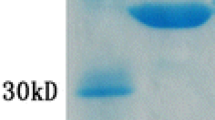Abstract
Harpin proteins stimulate hypersensitive response (HR) in plants. However, the mechanism by which HR is regulated is not clear. The role of the auxin, indole-3-acetic acid (IAA), in the control of harpin-stimulated HR was investigated. IAA was used to inhibit HR that was stimulated by purified fusion harpinXoo protein in tobacco. Semi-quantitative PCR and qRT-PCR were employed to detect the expression of HR related genes. IAA at 100 μM reversed harpin-induced HR which was inhibited by 500 μM 2,3,5-triiodobenzoic acid (TIBA). Semi-quantitative PCR and qRT-PCR showed the combined application of 100 μM IAA and harpin protein from Xanthomonas oryzae enhanced the expression of HR marker gene, hsr203J, but weakened the expression of the disease-defense gene, chia5. TIBA also decreased the expression of hsr203J but increased the expression of chia5. Thus, the auxin can reverse harpinXoo-induced HR.



Similar content being viewed by others
References
Andi S, Taguchi F, Toyoda K et al (2001) Effect of methyl jasmonate on harpin-induced hypersensitive cell death, generation of hydrogen peroxide and expression of PAL mRNA in tobacco suspension cultured BY-2 cells. Plant Cell Physiol 42:446–449
Gopalan S (2008) Reversal of an immunity associated plant cell death program by the growth regulator auxin. BMC Res Notes 1(1):126
Greenberg JT, Guo A, Klessig DF et al (1994) Programmed cell death in plants: a pathogen-triggered response activated coordinately with multiple defense functions. Cell 77:551–563
Hoyos ME, Stanley CM, He SY et al (1996) The interaction of harpinPss, with plant cell walls. MPMI 9(7):608–616
Lee J, Klessig DF, Nürnberger T (2001) A harpin binding site in tobacco plasma membranes mediates ctivation of the pathogenesis-related gene HIN1 independent of extracellular calcium but dependent on mitogen-activated protein kinase activity. Plant Cell Online 13:1079–1093
Li CM, Haapalainen M, Lee J et al (2005) Harpin of Pseudomonas syringae pv. phaseolicola harbors a protein binding site. Mol Plant-Microbe Interact 18:60–66
Miao W, Wang X, Li M et al (2010) Genetic transformation of cotton with a harpin-encoding gene hpaXoo confers an enhanced defense response against different pathogens through a priming mechanism. BMC Plant Biol 10:67
Racapé J, Belbahri L, Engelhardt S et al (2005) Ca2 +-dependent lipid binding and membrane integration of PopA, a harpin-like elicitor of the hypersensitive response in tobacco. Mol Microbiol 58:1406–1420
Robert-Seilaniantz A, Grant M, Jones JDG (2011) Hormone crosstalk in plant disease and defense: more than just jasmonate-salicylate antagonism. Ann Rev Phytopathol 49:317–343
Robinette D, Matthysse AG (1990) Inhibition by Agrobacterium tumefaciens and Pseudomonas savastanoi of development of the hypersensitive response elicited by Pseudomonas syringae pv. phaseolicola. J Bacteriol 172:5742–5749
Romano CP, Cooper ML, Klee HJ (1993) Uncoupling auxin and ethylene effects in transgenic tobacco and Arabidopsis plants. Plant Cell Online 5:181–189
Sohn SI, Kim YH, Kim BR et al (2007) Transgenic tobacco expressing the hrpN (EP) gene from Erwinia pyrifoliae triggers defense responses against botrytis cinerea. Mol Cell 24:232–239
Tampakaki AP, Panopoulos NJ (2000) Elicitation of hypersensitive cell death by extracellularly targeted HrpZPsph produced in planta. Mol Plant-Microbe Interact 13:1366–1374
Wei ZM, Laby RJ, Zumoff CH et al (1992) Harpin, elicitor of the hypersensitive response produced by the plant pathogen Erwinia amylovora. Science 257:85–88
Wen W, Wang J (2001) Cloning and expressing a harpin gene from Xanthomonas oryzae pv. oryzae. Acta Phytopathol Sin 31:296–300
Acknowledgments
This work was supported by grants from National Natural Science Foundation of China (31160359, 31360029); Doctoral Fund of Ministry of Education (20104601110004, 20124601110004); National Key Basic Research Plan of China (2011CB111612), National agricultural industrial technology system (ARS-34-GW8); research and start-up capital of Hainan University (kyqd1006). We are particularly grateful to Dr. R. H. Yan, for the helpful comments on the manuscript.
Author information
Authors and Affiliations
Corresponding author
Additional information
Jie Song and Xiao-chong Gong contributed to this work equally.
Electronic supplementary material
Below is the link to the electronic supplementary material.
Rights and permissions
About this article
Cite this article
Song, J., Gong, Xc., Miao, Wg. et al. Indole-3-acetic acid reverses the harpin-induced hypersensitive response and alters the expression of hypersensitive-response-related genes in tobacco. Biotechnol Lett 36, 1043–1048 (2014). https://doi.org/10.1007/s10529-013-1436-7
Received:
Accepted:
Published:
Issue Date:
DOI: https://doi.org/10.1007/s10529-013-1436-7




